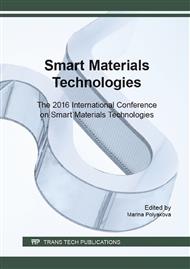p.8
p.12
p.16
p.20
p.28
p.39
p.43
p.48
p.53
Study the Relation between Flow, Thermal and Mechanical Properties of Waste Polypropylene Filled Silica Nanoparticles
Abstract:
This paper investigates the flow, thermal and mechanical properties of waste polypropylene (WPP) reinforced with silica (SiO2) nanoparticles (NPs). Recently the researches prove that the addition of NPs to the thermoplastic polymer produces significant change in its properties. SiO2 NPs of 0.001, 0.003, 0.006, 0.009, 0.012 and 0.015wt% were mixed with the WPP using twin screw extruder. The mixing process performed at 10 rpm and 190°C. The topography and particle size distribution of 0.001, 0.006 and 0.015 of SiO2 NPs concentrations samples are analyzed using atomic force microscopy (AFM). The crystallinity of nanocomposite was examined by X-ray diffraction. The melt flow rate (MFR) and melt volume rate (MVR) are tested due to SiO2 NPs concentration at standard condition using melt flow index (MFI) device. The shear viscosity and melt density are calculated using MFR and MVR values. Differential Scanning Calomitry (DSC) is used to show the effect of SiO2 NPs concentration on the thermal history of nanocomposite. Charpy impact strength and hardness are tested. The results show that the MFR and MVR increase with the NPs concentration increasing. The shear viscosity decreases with MFR and MVR increasing. The crystallinity level and the crystallinity temperature decreases with SiO2 NPs concentration increasing while impact and hardness increasing. Clear difference between solid and melt density is observed. There is a compatible between the thermal, flow and mechanical properties of different SiO2 nanocomposite samples.
Info:
Periodical:
Pages:
28-38
Citation:
Online since:
December 2016
Authors:
Price:
Сopyright:
© 2017 Trans Tech Publications Ltd. All Rights Reserved
Share:
Citation:


